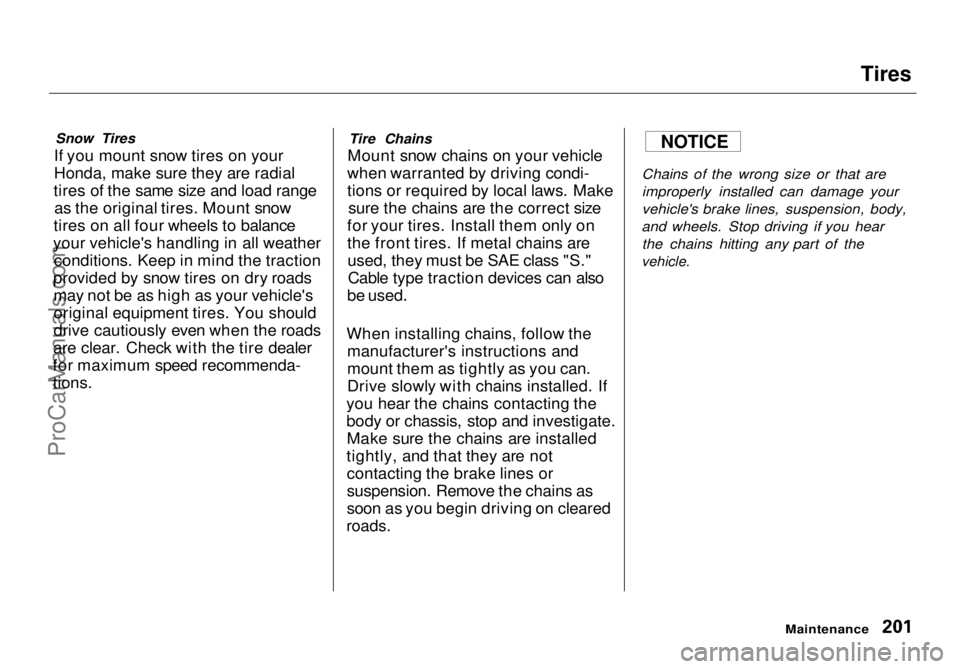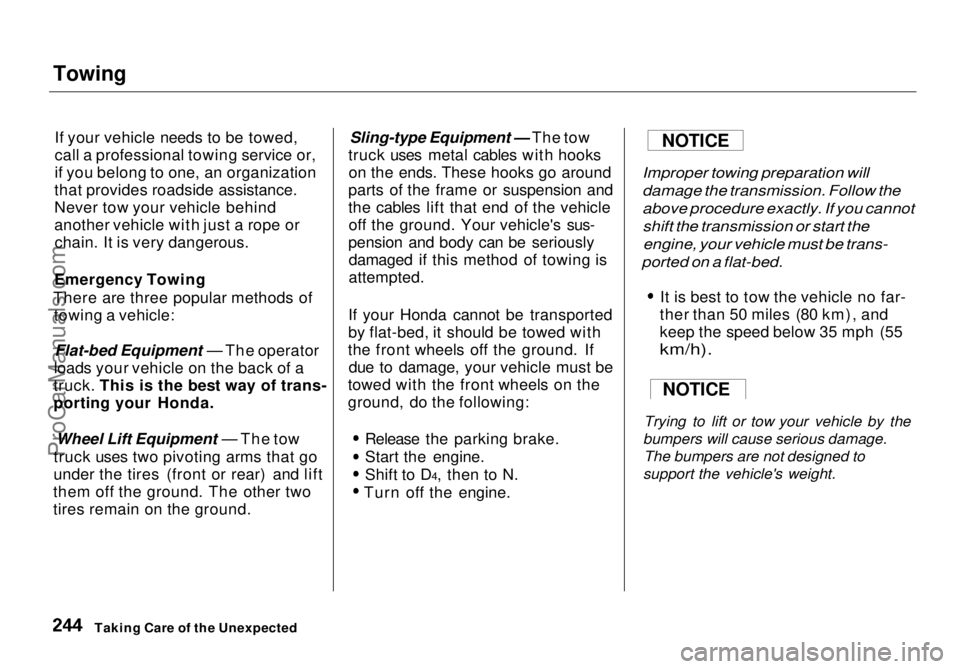Page 200 of 272

Tires
Snow Tires
If you mount snow tires on your
Honda, make sure they are radial
tires of the same size and load range as the original tires. Mount snow
tires on all four wheels to balance
your vehicle's handling in all weather conditions. Keep in mind the traction
provided by snow tires on dry roads may not be as high as your vehicle's
original equipment tires. You should
drive cautiously even when the roads
are clear. Check with the tire dealer
for maximum speed recommenda-
tions. Tire Chains
Mount snow chains on your vehicle
when warranted by driving condi-
tions or required by local laws. Make sure the chains are the correct size
for your tires. Install them only on
the front tires. If metal chains are used, they must be SAE class "S."Cable type traction devices can also
be used.
When installing chains, follow the manufacturer's instructions and
mount them as tightly as you can.
Drive slowly with chains installed. If
you hear the chains contacting the
body or chassis, stop and investigate. Make sure the chains are installed
tightly, and that they are not contacting the brake lines or
suspension. Remove the chains as
soon as you begin driving on cleared
roads.
Chains of the wrong size or that are
improperly installed can damage your
vehicle's brake lines, suspension, body,
and wheels. Stop driving if you hear
the chains hitting any part of the
vehicle.
Maintenance
NOTICEProCarManuals.comMain Menu Table of Contents s t
Page 204 of 272
Lights
VERTICAL ANGLE GAUGE
5. Check the vertical angle gauge. The bubble should be centered
underneath the longest scribe
mark on the gauge. HORIZONTAL ADJUSTMENT
6. If either indicator is not aligned with its "0" mark as described, an
adjustment can be made using a
Phillips-head screwdriver to
realign it with the "0" mark. Please
refer to the illustrations. VERTICAL ADJUSTMENT
7. If you cannot get an indicator to align, have your Honda dealer
inspect the vehicle for body damage or suspension problems.
MaintenanceProCarManuals.comMain Menu Table of Contents s t
Page 241 of 272

Towing
If your vehicle needs to be towed,
call a professional towing service or,
if you belong to one, an organization
that provides roadside assistance.
Never tow your vehicle behind
another vehicle with just a rope or chain. It is very dangerous.
Emergency Towing
There are three popular methods of towing a vehicle:
Flat-bed Equipment — The operator
loads your vehicle on the back of a
truck. This is the best way of trans-
porting your Honda.
Wheel Lift Equipment — The tow
truck uses two pivoting arms that go
under the tires (front or rear) and lift
them off the ground. The other two
tires remain on the ground.
Sling-type Equipment — The tow
truck uses metal cables with hooks on the ends. These hooks go around
parts of the frame or suspension and
the cables lift that end of the vehicle off the ground. Your vehicle's sus-
pension and body can be seriously damaged if this method of towing is
attempted.
If your Honda cannot be transported
by flat-bed, it should be towed with
the front wheels off the ground. If due to damage, your vehicle must be
towed with the front wheels on the
ground, do the following:
Release the parking brake.
Start the engine.
Shift to D4, then to N.
Turn off
the engine.
Improper towing preparation will
damage the transmission. Follow the
above procedure exactly. If you cannot
shift the transmission or start the
engine, your vehicle must be trans-
ported on a flat-bed.
It is best to tow the vehicle no far-
ther than 50 miles (80 km), and
keep the speed below 35 mph (55
km/h).
Trying to lift or tow your vehicle by the
bumpers will cause serious damage. The bumpers are not designed to
support the vehicle's weight.
Taking Care of the Unexpected
NOTICE
NOTICEProCarManuals.comMain Menu Table of Contents s t